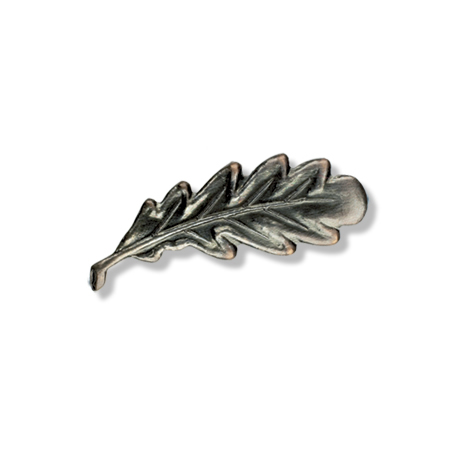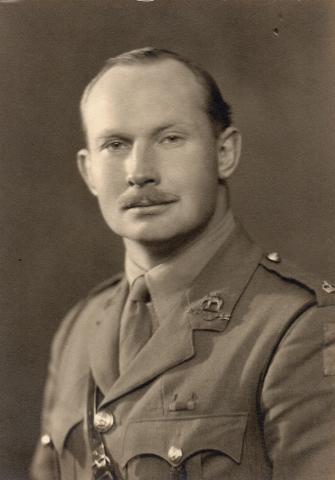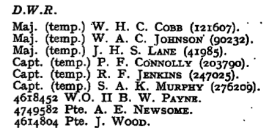John Henry Stow Lane was born on the 6 November 1910 in India.
He served in The Eastbourne College Contingent , Junior Division, of the Officer Training Corps and had reached the rank of Corporal, when he was commissioned as a Second Lieutenant in the 86th (East Anglian) (Hertfordshire Yeomanry) Field Brigade, RA (TA) on the 9 May 1929.
He was then granted a regular commission in The Duke of Wellington’s Regiment (West Riding) on the 30 January 1931, and went on to serve with the 2nd Battalion on the North West Frontier of India.
He was awarded the India General Service Medal in September 1936. He was promoted to Captain on the 28 January 1940.
In 1942, and by now a Major, he volunteered for Airborne Forces and was posted to the 4th Parachute
Battalion on the 5 January 1942 as the Officer Commanding ‘C’ Company.
He did Parachute Course No 10, at RAF Ringway, 16 – 27 March 1942.
John served in the post of Second-in-Command of the Depot and School Airborne Forces at Hardwick Hall, and was present on the visit of Maj-Gen. FAM. Browning on the 26 August 1942, when an Officers group photo was taken.
Posted to the 2nd Parachute Battalion, then in North Africa, on the 20 January 1943. He assumed command of ‘A’ Company on the 5 February 1943, after Major. Ashford was killed in action.
He was still in command of ‘A’ Company during the Battle of Tamera: ‘At dawn on 8 March the enemy attacked in two thrusts, one against the 1st Battalion, the other against the 2nd. The 2nd Battalion had only just taken over from the Lincolns in the dark and so were caught slightly off balance and ‘A’ Company suffered a number of casualties. Its commander, Major Lane, rang up battalion headquarters to say,
“We appear to be completely surrounded now, but I am sure it will be all right.”
The enemy had almost reached headquarters and ‘A’ Company required ammunition urgently. Each time a mule column was formed up it was scattered by mortar fire. Captain Radcliffe, the adjutant, was killed while leading a charge with an escort for an ammunition column trying to reach the Company.’ [1]
By July 1943 he was the Second-in-Command of the 2nd Parachute Battalion, but was reported missing, on the parachute operation in Sicily, 14 July 1943. He was confirmed as a POW on the 21 July 1943. Initially he was sent to an Italian POW Camp, but after the capitulation in September 1943, he was moved to a German POW Camp, Oflag 2B at Arnswalde in Poland, and then to Oflag 9A/Z at Rotenburg in Germany. His POW No 1632. On the 10 July 1945 Major. Lane joined the 22nd Independent Parachute Company, whilst it was based at Longford Castle, near Salisbury, Wiltshire. Eleven days later he was on his way, by air, to Karachi, in North-West India, arriving there on the on the 26 July 1945. The Company was attached to the 5th Parachute Brigade, which was the lead element of the 6th Airborne Division, under orders for the Far East theatre of operations. On the 29 July Major Lane moved to Kalyan on the West Coast of India. After several weeks training in the nearby area the Company embarked at Bombay on the SS Chitral, a troopship, 7 September and sailed the next day. On the 18 September the Company embarked on an LCI. in full battle order, and then onto LCAs for a landing at Morib Beach, to the South-West of Kuala Lumpar. The next day they re-embarked on the LCAs for transfer back to the LCI, and then back on board the SS Chitral. The ship then sailed for Singapore where the Company disembarked on the 23 September.
The Company remained in Singapore for the next three months. Major Lane was taken ill on the 14 December and admitted to Hospital, where he remained until mid-February 1946. When, on the 18 February, he re-joined the 22nd Ind Para Company, it was based at Semerang in Java. Here the unit was involved in Internal Security duties against the locals who were fighting for Independence from the Dutch.
Major Lane was involved in leading several patrols against the Indonesian’s, especially on the 24 March 1946, when a strong force of the Company encountered opposition and suffered two men killed in the ensuing engagement.
In early May 1946 the Company, along with the rest of the 5th Parachute Brigade, moved to Malaya, and Major Lane went on attachment to the 2nd Infantry Division on the 27 May. It is not known if he returned to the Company, but in August 1946 the Company sailed for the Middle East, to join the rest of the 6th Airborne Division, where it arrived at Port Said in Egypt on the 8 August. From here it moved to Camp 22 at Nathanya in Palestine, on the 21 August it was officially disbanded.
It would appear that the award of a Mention in Despatches for service in Burma, whilst serving with The Duke of Wellington’s Regiment, announced in the London Gazette on the 19 September 1946, is a slight error and should have been for service as the Officer Commanding the 22nd Independent Parachute Company in Java!
After he left the Army he became the Bursar in a Prep School at Edge Hill, Wimbledon.
John Henry Stow Lane died suddenly on the 23 January 1983.
NOTES:
[1] THE RED BERET, by Hilary St George Saunders, page 112.
Created with information kindly supplied by R Hilton. Profile photograph researched by R Hilton from the Airborne Assault Archives.
Read More



Latest Comments
There are currently no comments for this content.
Add Comment
In order to add comments you must be registered with ParaData.
If you are currently a ParaData member please login.
If you are not currently a ParaData member but wish to get involved please register.